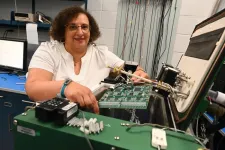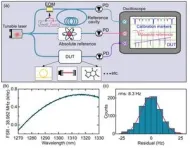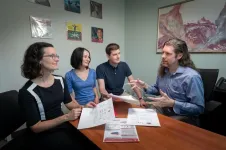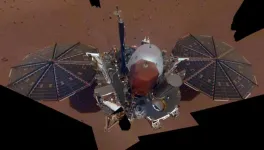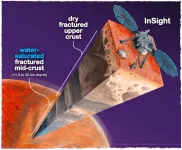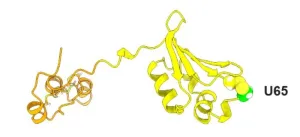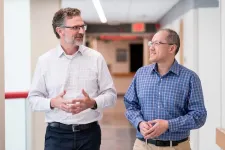(Press-News.org) UPTON, N.Y. — Physicist Mary Bishai of the U.S. Department of Energy’s (DOE) Brookhaven National Laboratory has been named a 2024 DOE Office of Science Distinguished Scientist Fellow. The honor recognizes her “enduring contributions at the intensity frontier of high energy physics in unraveling fundamental properties of neutrinos, extraordinary leadership and service to the particle physics community, and deep commitment to broadening participation through mentoring next generation scientists.”
As described in a DOE Office of Science press release issued today, the Distinguished Scientist Fellows program was established to develop, sustain, and promote scientific and academic excellence in Office of Science research through collaborations between universities and national laboratories. Bishai, one of four scientists being honored this year, will receive the award — which consists of $1 million in direct funding for her research — at a ceremony on January 14, 2025, where she will also deliver an online lecture and field questions about her career.
“It is an honor to recognize the outstanding research of these awardees,” said Harriet Kung, acting director of the DOE Office of Science. “They are advancing science solutions for the nation and taking on some of our biggest challenges in bioenergy, materials science, physics, and computing. I look forward to their continued success and impactful results, especially as they continue to move forward in their careers, inspiring a new generation of scientists ready to tackle the big questions and challenges of the future.”
Bishai has made understanding the properties of elementary particles her life’s work, and she has spent the last two decades at Brookhaven working to understand the properties of the elusive neutrino. Her leadership on neutrino experiments led her to be elected co-spokesperson of the Deep Underground Neutrino Experiment (DUNE) in January 2023. DUNE is a 1,400-person project with scientists from more than 30 countries and 200 institutions. This experiment will shoot neutrinos over a thousand kilometers from DOE’s Fermi National Accelerator Laboratory (Fermilab) in Illinois through Earth’s crust to detectors deep within the Sanford Underground Research Facility (SURF) in South Dakota to see how these enigmatic entities change as they travel.
“This fellowship is a great honor,” she said. After spending her early career working at Purdue University and studying charm quarks at the CLEO experiment at Cornell University, Bishai transitioned to work at DOE laboratories. She reflected, “I have spent a rewarding career involved in leading particle physics experiments at the national labs, including 20 years at Brookhaven.”
Bishai is excited for DUNE’s possible insight into several fundamental questions in physics. Chief among those is why our universe is made of matter, or as she put it, “why we are here.” DUNE will allow scientists to look for differences between how neutrinos and their antimatter opposites, antineutrinos, behave. Finding a difference could help explain why the early universe — which should have contained the two in equal, mutually annihilating amounts — somehow favored the existence and persistence of matter. Observations by terrestrial detectors like DUNE of the energy and time distributions of neutrinos emitted by the sun or during the explosion of a nearby supernova will also provide a clearer picture of how stars work.
Bishai’s outlook and enthusiasm extend beyond the science to the scientists themselves. “The most fun of all,” she said, has been guiding the next generation of researchers. “As a mentor, I am making sure that my students are integrated, making sure they understand what they're doing, and I’m trying to talk about careers a lot,” she shared.
Detection detective
Brookhaven scientists have been at the forefront of neutrino research for decades, developing complex detector technologies, including giant liquid argon-filled detectors and the cold microelectronics that read out their signals. Bishai’s work builds on that legacy.
“Brookhaven is where the first successful neutrino beam from an accelerator was produced as part of a Nobel Prize-winning experiment that established that neutrinos have ‘flavors,’ or different types. This was followed by Ray Davis’ groundbreaking Nobel Prize-winning experiment to detect solar neutrinos using a massive detector underground in the former Homestake Gold Mine in South Dakota. That experiment produced the first hint that neutrinos oscillate, or change, between different flavors. DUNE is the latest generation, using accelerator-produced neutrinos to further study neutrino flavor oscillations to learn more about our universe,” Bishai said.
Part of the challenge with all these experiments is that neutrinos have extraordinarily little mass, no charge at all, and interact with matter only rarely. So how exactly do scientists measure a chargeless particle that can fly through walls with ease while shapeshifting among three known flavors? The key is in detecting “fingerprints” neutrinos leave in the argon bath.
As in many of the earlier experiments, DUNE’s detectors will be deep underground to filter out other types of particle interactions. When incoming neutrinos enter the chilly, 87 Kelvin (-303 degrees Fahrenheit) pool of liquid argon, they’ll very occasionally interact with one of the argon atoms. Those interactions kick various charged particles out of the argon nuclei. Next, the charged particles set off a cascade of ionization, knocking electrons off more atoms in the argon bath. The interactions of the initial neutrino and the secondary charged particles with argon also generate flashes of light.
Scientists match the flashes of light, which travel almost instantaneously through the detector, with the later arrival of electrons freed by ionization as they strike electrodes on the sides of the detector.
“Because you know how fast it takes for the charge to go, and you know when the interaction happened from the flash of light, you can figure out exactly where the interaction took place inside the detector, and you can use computers to reconstruct the tracks,” Bishai said.
Then, it’s about fitting the puzzle pieces together. Since each neutrino produces different types of tracks, these tracks can be analyzed to pinpoint the flavor of the neutrino that created each track.
Keeping it inclusive — for data and people
Bishai has been recognized for being a relentless champion for the science of neutrinos and the scientific program of the DUNE experiment, starting from her role as project scientist when the DUNE collaboration was first formed in 2015 and subsequently as a leader of various physics working groups in the collaboration.
Throughout her career, and as DUNE co-spokesperson, she has worked consistently to bring others into the field.
As an example, she has mentored more than 20 young scientists, mostly through the DOE-funded Science Undergraduate Laboratory Internship program at Brookhaven Lab, and students who visited Brookhaven while participating in the African School of Physics. Bishai recalled how she worked with students to test hundreds of DUNE’s cold microelectronic chips by dipping them in liquid nitrogen that’s nearly as cold as the liquid argon will be.
“I learn more when I teach because I have to dig deep into the science myself, dig deep into the technical issues, to be able to then translate it into simpler concepts,” she said.
Bishai believes that giving students a chance to participate in DUNE — not just her own students but those of many scientists connected with the project — will help produce a workforce adept at “organizing large, collaborative, multidisciplinary efforts across the world.”
The cornerstone of a project this size is indeed making everyone feel welcome and ensuring that collaborators around the globe have access to the scientific data. “DUNE is moving to a very distributed approach in terms of analyzing and accessing data internationally,” she said.
Bishai is also working to cultivate an inclusive team atmosphere. As DUNE co-spokesperson, she helped launch a DUNE inclusion, diversity, equity, and accessibility group that is gathering demographic information and programs activities to increase representation.
Another initiative was instituting an orientation session at certain DUNE collaboration meetings. “Anybody who wants to come can learn about how collaboration decisions are made and how to join in the decision-making process,” Bishai said.
She has additionally prioritized increased involvement of early career staff, including members of the Young DUNE group, on DUNE committees and decision-making bodies. Bishai tries to make herself available to all collaboration members through both formal Q&A sessions and informal messaging platforms and email.
“Being co-spokesperson of the DUNE collaboration, you are elected to serve all collaborators regardless of seniority,” she said. “You have to lead by building consensus among a group of equals.”
Bishai earned her Bachelor of Arts in physics at the University of Colorado, Boulder in 1991. She received her Master of Science and Ph.D., both in physics, from Purdue University in 1993 and 1999, respectively. She was a research associate at DOE’s Fermilab in 1998 until she joined Brookhaven as an assistant physicist in 2004. She rose through the ranks and has been a senior physicist since 2015. Bishai has played many roles in laying the foundation for a U.S.-based long-baseline neutrino experiment and became DUNE Collaboration co-spokesperson in 2023. In 2014, she was named Woman of the Year in Science by the Town of Brookhaven, and in 2015, she was elected a fellow of the American Physical Society.
Brookhaven National Laboratory is supported by the Office of Science of the U.S. Department of Energy. The Office of Science is the single largest supporter of basic research in the physical sciences in the United States and is working to address some of the most pressing challenges of our time. For more information, visit science.energy.gov.
Follow @BrookhavenLab on social media. Find us on Instagram, LinkedIn, X, and Facebook.
Related Links
Department of Energy Announces 2024 Office of Science Distinguished Scientists Fellows and Lecture Series END
Mary Bishai named Distinguished Scientist Fellow
Department of Energy Office of Science recognizes Brookhaven physicist for her leadership in neutrino studies and for mentoring young scientists
2024-08-12
ELSE PRESS RELEASES FROM THIS DATE:
Can meditation and stretching relieve cramping caused by cirrhosis?
2024-08-12
People suffering from cirrhosis may find some symptom relief from two accessible activities: stretching and meditation.
A study from the University of Michigan compared the two therapies as a means to relieve nocturnal muscle cramps and found both effective.
The resulting paper, “The RELAX randomized controlled trial: Stretching versus meditation for nocturnal muscle cramps,” appeared in Liver International.
The study
Two out of every three people with cirrhosis experience muscle cramps at night that wake them from sleep.
Since ...
Study reveals oleoyl-ACP-hydrolase underpins lethal respiratory viral disease
2024-08-12
Respiratory infections can be severe, even deadly, in some individuals, but not in others. Scientists at St. Jude Children’s Research Hospital, the Peter Doherty Institute for Infection and Immunity and other collaborators have gained new understanding of why this is the case by uncovering an early molecular driver that underpins fatal disease. Oleoyl-ACP-hydrolase (OLAH) is an enzyme involved in fatty acid metabolism. A study, published today in Cell, shows that OLAH drives severe disease outcomes.
The important role of OLAH in immune response has gone unrecognized for several reasons, including a lack of noticeable expression in healthy ...
Advances in drug delivery carrier microwave-assisted reactions for enhanced therapeutics and diagnostic purposes
2024-08-12
Microwave irradiation technology is emerging as a powerful tool in the fields of organic synthesis, pharmaceuticals, and nanocarrier development. Recently, microwave-assisted reactions have gained significant attention for their effectiveness in synthesizing drug delivery carriers. This technology offers notable advantages, including high yield, shorter reaction times, and improved compound purity, making it a promising approach for developing nanoparticles with enhanced physicochemical properties and bioavailability.
For more information, please visit: bit.ly/3SFk4cf
For contributing article in this research topic, visit: bit.ly/3WXyoza
Use ...
Presence of liquid water most probable explanation for data collected by mars lander
2024-08-12
Data about Mars’ planetary crust gathered from the Mars InSight lander are best explained by the conclusion that the crust has stores of liquid water.
Analysis led by Vashan Wright, a geophysicist at UC San Diego’s Scripps Institution of Oceanography, provides the best evidence to date that the planet still has liquid water in addition to that frozen at its poles. If that conclusion is true, it sets the stage for new research considering the planet’s habitability and continuing a search for life that exists on a place other than Earth. The potential presence of liquid water on Mars has tantalized scientists for decades. Water is essential for a habitable planet.
“Understanding ...
Scientists find oceans of water on Mars. It's just too deep to tap.
2024-08-12
Using seismic activity to probe the interior of Mars, geophysicists have found evidence for a large underground reservoir of liquid water — enough to fill oceans on the planet's surface.
The data from NASA's Insight lander allowed the scientists to estimate that the amount of groundwater could cover the entire planet to a depth of between 1 and 2 kilometers, or about a mile.
While that’s good news for those tracking the fate of water on the planet after its oceans disappeared more than 3 billion years ago, the reservoir won't be of much use to anyone trying to tap into it to supply a future Mars colony. It's ...
UMass Amherst researchers ID body’s ‘quality control’ regulator for protein folding
2024-08-12
AMHERST, Mass. – Anyone who’s tried to neatly gather a fitted sheet can tell you: folding is hard. Get it wrong with your laundry and the result can be a crumpled, wrinkled mess of fabric, but when folding fails among the approximately 7,000 proteins with an origami-like complexity that regulate essential cellular functions, the result can lead to one of a multitude of serious diseases ranging from emphysema and cystic fibrosis to Alzheimer’s disease. Fortunately, our bodies have a quality-control system ...
Forest restoration can boost people, nature and climate simultaneously
2024-08-12
Forest restoration can benefit humans, boost biodiversity and help tackle climate change simultaneously, new research suggests.
Restoring forests is often seen in terms of “trade-offs” – meaning it often focuses on a specific goal such as capturing carbon, nurturing nature or supporting human livelihoods.
The new study, by the universities of Exeter and Oxford, found that restoration plans aimed at a single goal tend not to deliver the others.
However, “integrated” plans would deliver over 80% of the benefits in all three areas at once.
It also found that ...
Pre-surgical antibody treatment might prevent heart transplant rejection
2024-08-12
A new study from scientists at Cincinnati Children’s suggests there may be a way to further protect transplanted hearts from rejection by preparing the donor organ and the recipient with an anti-inflammatory antibody treatment before surgery occurs.
The findings, published online in PNAS, focus on blocking an innate immune response that normally occurs in response to microbial infections. The same response has been shown to drive dangerous inflammation in transplanted hearts.
In the new study – in mice -- transplanted hearts functioned for longer periods when the organ recipients ...
Scientists identify genes linked to relapse in the most common form of childhood leukemia
2024-08-12
Scientists from St. Jude Children’s Research Hospital, Seattle Children’s and the Children’s Oncology Group (COG) have identified novel genetic variations that influence relapse risk in children with standard risk B-cell acute lymphoblastic leukemia (SR B-ALL), the most common childhood cancer. The identification of genomic predictors of relapse in SR B-ALL provides a basis for improved diagnosis, precise tailoring of treatment intensity and potentially the development of novel treatment approaches. The study was published today in the Journal of ...
Local solvation is decisive for fluorescence of biosensors
2024-08-12
At Ruhr University, the groups of Professor Martina Havenith and Professor Sebastian Kruss collaborated for the study, which took place as part of the Cluster of Excellence “Ruhr Explores Solvation”, RESOLV for short. The PhD students Sanjana Nalige and Phillip Galonska made significant contributions.
Carbon nanotubes as biosensors
Single-walled carbon nanotubes are powerful building blocks for biosensors, as previous studies revealed. Their surface can be chemically tailored with biopolymers or DNA fragments to interact specifically with a certain target molecule. When such molecules bind, the nanotubes change their emission ...
LAST 30 PRESS RELEASES:
Making lighter work of calculating fluid and heat flow
Normalizing blood sugar can halve heart attack risk
Lowering blood sugar cuts heart attack risk in people with prediabetes
Study links genetic variants to risk of blinding eye disease in premature infants
Non-opioid ‘pain sponge’ therapy halts cartilage degeneration and relieves chronic pain
AI can pick up cultural values by mimicking how kids learn
China’s ecological redlines offer fast track to 30 x 30 global conservation goal
Invisible indoor threats: emerging household contaminants and their growing risks to human health
Adding antibody treatment to chemo boosts outcomes for children with rare cancer
Germline pathogenic variants among women without a history of breast cancer
Tanning beds triple melanoma risk, potentially causing broad DNA damage
Unique bond identified as key to viral infection speed
Indoor tanning makes youthful skin much older on a genetic level
Mouse model sheds new light on the causes and potential solutions to human GI problems linked to muscular dystrophy
The Journal of Nuclear Medicine ahead-of-print tip sheet: December 12, 2025
Smarter tools for peering into the microscopic world
Applications open for funding to conduct research in the Kinsey Institute archives
Global measure underestimates the severity of food insecurity
Child survivors of critical illness are missing out on timely follow up care
Risk-based vs annual breast cancer screening / the WISDOM randomized clinical trial
University of Toronto launches Electric Vehicle Innovation Ontario to accelerate advanced EV technologies and build Canada’s innovation advantage
Early relapse predicts poor outcomes in aggressive blood cancer
American College of Lifestyle Medicine applauds two CMS models aligned with lifestyle medicine practice and reimbursement
Clinical trial finds cannabis use not a barrier to quitting nicotine vaping
Supplemental nutrition assistance program policies and food insecurity
Switching immune cells to “night mode” could limit damage after a heart attack, study suggests
URI-based Global RIghts Project report spotlights continued troubling trends in worldwide inhumane treatment
Neutrophils are less aggressive at night, explaining why nighttime heart attacks cause less damage than daytime events
Menopausal hormone therapy may not pose breast cancer risk for women with BRCA mutations
Mobile health tool may improve quality of life for adolescent and young adult breast cancer survivors
[Press-News.org] Mary Bishai named Distinguished Scientist FellowDepartment of Energy Office of Science recognizes Brookhaven physicist for her leadership in neutrino studies and for mentoring young scientists
